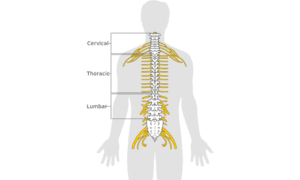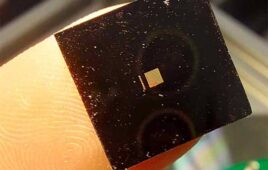
[Image from Wikipedia]
Motor function was recovered after study participants received long-term activity-based training and spinal cord epidural stimulation (scES). After approximately 34.5 months, the participants could recover substantial voluntary lower-limb motor control and were able to stand without scES.
“Activity-dependent plasticity can re-establish voluntary control of movement and standing after complete paralysis in humans even years after injury,” Susan Harkema, one of the researchers on the study, said in a press release. “This should open up new opportunities for recovery-based rehabilitation as an agent for recovery, not just learning how to function with compensatory strategies, even for those with the most severe injuries.”
Previous research at the Kentucky Spinal Cord Injury Research Center (KSCIRC) found that activity-based training using electrical signals delivered to motor neurons in the spine using an implanted device could make patients stand again while performing other voluntary lower limb movements when the scES device was in-use.
The training that participants of the new study had to go through included one hour of activity-based training sessions using an epidural stimulation. The participants were trained on standing activity over several months followed by stepping training for several months.
After several months of in-lab training and at-home training, one participant, Andrew Meas, could voluntarily extend his knees with hip flexion improvement. He also required minimal additional assistance when using the upper body to reach from a standing position. Meas could also stay in a standing position without assistance and could stand on one leg.
“We observed that in participants we have worked with so far, eight months of activity-based training with stimulation did not lead to any improvement without stimulation,” said Enrico Rejc, assistance professor in the University of Louisville department of neurological surgery and first author on the study. “This participant kept training at home and, after several months, he came back to the lab and we tried a different training protocol. After a couple of months of training with the new protocol, we surprisingly observed that we was able to stand without any stimulation – with two legs and with one leg – using only his hands for balance control.”
Activity-based training with scES helped remodel the connections between neurons in the spinal cord to help restore movement, according to the researchers. Also, a continued effort of voluntary movement helped expedite recovery.
“The voluntary component of him trying constantly with spinal stimulation on and while performing motor tests can lead to unexpected recovery,” Rejc said. “The human nervous system can recover from severe spinal cord injury even years after injury. IN this case, he was implanted with the stimulator four years after his injury. We saw motor recovery two years later – so six years after injury.”
The research was published in the journal Scientific Reports and was funded by the Christopher and Dana Reeve Foundation, the Leona B. and Harry B. Helmsley Charitable Trust, Medtronic and the National Institutes of Health.




